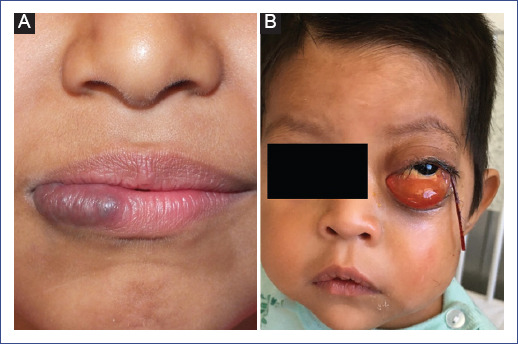Introduction
Vascular malformations (VaM) are a heterogeneous group of disorders with endothelial cell dysmorphogenesis, classified as (1) simple, (2) combined, (3) of major named vessels, and (4) associated with other anomalies1. Their correct classification is relevant to provide adequate treatment according to evidence-based medicine. The International Society for the Study of Vascular Anomalies (ISSVA) periodically updates this classification to standardize terminology, including new genetic and clinical findings. However, physicians who are not familiar with these patients may need more clarification with diagnostic terminology to prevent inadequate evaluation, management, and prognosis1-3.
This study aimed to measure the concordance between referral diagnoses of new pediatric VaM patients sent to the Vascular Anomalies Clinic (VAC) and the final confirmed diagnoses.
Methods
We conducted a retrospective study of 435 patients referred between 2012 and 2022 to our institution's Vascular Anomalies Clinic (VAC). First, we reviewed the diagnoses provided at the time of referral and then those established by our team according to the ISSVA after evaluating clinical, imaging, and histological findings. We used descriptive statistics and Fleiss kappa (k) concordance analysis with the following interpretation: ≤ 0 indicated no concordance; 0.01-0.20, none to mild; 0.21-0.40, fair; 0.41-0.60, moderate; 0.61-0.80 substantial; and 0.81-1.00, near perfect concordance.
Results
Fifty-one percent of patients were female, with a mean age at initial diagnosis of 50.31 months (standard deviation (SD) ± 51.86). Simple VaMs were observed in 300 patients: 162 with lymphatic malformations (LM), 82 with venous malformations (VM), 46 with arteriovenous malformations (AVM), and ten with capillary malformations (CM). Combined VaMs were observed in 109 patients: 107 with slow-flow (CM ± LM ± VM) and two with high-flow. VaMs associated with other anomalies were identified in 23 patients, and provisionally not classified conditions were observed in three patients.
Fifty-eight percent of patients were correctly diagnosed with VaM. The rest of the patients were misdiagnosed, as they had a different condition: vascular tumor (17.4%), neoplasm (11.7%), cyst/abscess/infection (5.4%), and others (9.4%). Patients were referred by pediatricians (146), surgeons (146), dermatologists (61), and primary care physicians (30). Dermatology (62.2%), neonatology (50%), oncology (50%), surgery (42.8%), and pediatrics (38.3%) most frequently diagnosed patients correctly.
When analyzed by specific VaM subtypes, we found 53% of LM, 30.4% of VaM associated with other anomalies, 23.9% of AVM, 20% of CM, and 10.9% of VM were correctly diagnosed. Overall, the diagnostic concordance between referral and final diagnoses was fair (κ 0.306, standard error (SE) 0.064, p < 0.001); for LM and VaM associated with other anomalies, it was moderate (κ 0.593 and κ 0.469, respectively) (Figure 1).
Discussion
Suboptimal diagnostic concordance of VaM impairs communication, treatment, and research in this field3; a low yield of correct referral diagnoses of VaM has been reported. Greene et al. found that 45.6% of 3,645 patients were labeled correctly at referral, particularly LM (69.3%) and AVM (59.4%)4. LMs are frequent VaM5 and, together with AVM, have distinctive clinical features, which may explain why they can be more frequently correctly identified. Only LM and VaM associated with other anomalies had moderate diagnostic concordance in our study.
Low diagnostic consistency has been reported even at centers with VACs. For example, Pahls et al. reported a concordance of 9%, reflecting physicians' lack of familiarity or resistance to adopting ISSVA terminology rather than insufficient knowledge6. Additionally, the correct diagnosis of VaM may be more problematic than tumors because they are less common, and physicians should be familiar with the full spectrum4. Vascular anomalies are only sometimes taught to medical students. Moreover, residents and specialty practitioners who care for these patients receive limited exposure and training7.
The main problem of misdiagnosis is the impact on patient care. For example, patients with VaM may be misdiagnosed as infantile hemangiomas and prescribed ineffective medical treatment (Figure 2A) or diagnosed with neoplastic diseases and consequently treated with improper procedures (Figure 2B).

Figure 2 A. Patient with a venous malformation (VM) from birth on the lower lip that was diagnosed as a nevus. At 3 years of age, the lesion increased in size and volume and became painful. She was diagnosed with a hemangioma and treated with propranolol and topical corticosteroids for 6 months. Due to a lack of response, she was referred to the Vascular Anomalies Clinic (VAC), where she was successfully treated with polidocanol sclerotherapy. B. Patient with retroorbital venous-lymphatic malformations (VLM) observed at 2 years of age due to volume increase and proptosis after trauma. Computerized tomography findings suggested the probable diagnosis of alveolar rhabdomyosarcoma. A biopsy was performed, complicated by hemorrhage requiring drainage and tarsorrhaphy. Once diagnosed with VLM, the patient was referred to the VAC. Unfortunately, by this time, we found severe vision loss.
The following ways to fill this niche are proposed:
Facilitating trainees' exposure to specialized multidisciplinary groups/clinics that care for patients with vascular anomalies, as they are the cornerstone of proper training.
Specialties involved in the care of these patients should advocate for this topic to be part of their conferences and journals.
Development and distribution of specific guidelines or pathways, such as the European Vascular Anomalies (VASCA) Working Group8.
Inclusion of vascular anomalies as part of the dermatology curriculum for medical students.
Limitations of this study include the retrospective design and the limited number of patients with some types of VaM. However, we used the k coefficient, considered the gold standard for measuring concordance by excluding random coincidences.
In conclusion, we found fair concordance between referral and final diagnoses of VaM. Continuing medical education strategies are necessary to improve adequate diagnoses and, therefore, the management of these patients.











 nueva página del texto (beta)
nueva página del texto (beta)



